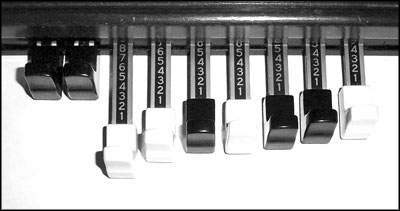The HAMMOND ORGAN
North Suburban HAMMOND ORGAN Service

Figure 20. This picture shows you part of the keyboard area of a typical Hammond console. The controls just over the upper keyboard are the so-called Hammond harmonic drawbars by means of which the musician selects the individual harmonic pitches which should be present on every key and also the volume at which they should sound. The twelve reverse-colored keys to the left of the keyboards are preset keys. Favorite combinations of harmonic drawbars can be set up inside the console. Then the simple expedient of pressing a preset key brings up that combination.
The beauty of the Hammond vibrato system is that it produces a very good vibrato which on its maximum setting is very full and rich sounding. The lower settings are more subtle but they are also very useful for creating specific effects. Because the Hammond vibrato system adds the vibrato to waveforms that have already been produced, it will also add vibrato to any signal which is fed into the system. Thus, if you desired to run signals from an amplified chime unit, or a MIDI keyboard, or even another electronic organ whose vibrato is not as good-sounding, it is easily possible to do this.
So far, we have looked at the basic Hammond tone generating system, touched upon how the Hammond produces different tone colors and examined its unique vibrato system in some detail. We should look now at the means in which the Hammond produces different tone colors in a little more detail. Below is a picture showing a portion of the keyboards of a typical tone wheel Hammond console.
At the upper left are three white controls. The first one affects the over-all volume of the instrument giving either "soft" volume or normal. The other two controls place the vibrato effect on either keyboard as the musician desires.
If a drawbar is pushed all the way in, it connects to ground and the harmonic it represents is not present in the resulting tone. In this picture, the first two drawbars are pushed all the way in to the “zero” position. I placed a sheet of paper under the drawbars in this picture to improve the legibility of the picture.

Figure 21. A single group of drawbars showing a set-up for a general accompaniment type tone. Most experienced Hammond players rarely memorize the numerical combinations of drawbars but rather go by the shape or pattern that they make.
The next picture, figure twenty-one shows you one individual group of drawbars. Notice that each has a label strip with numbers one to eight, representing the eight different volume levels for each drawbar.
Previous page Page 11. Next page